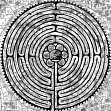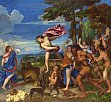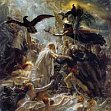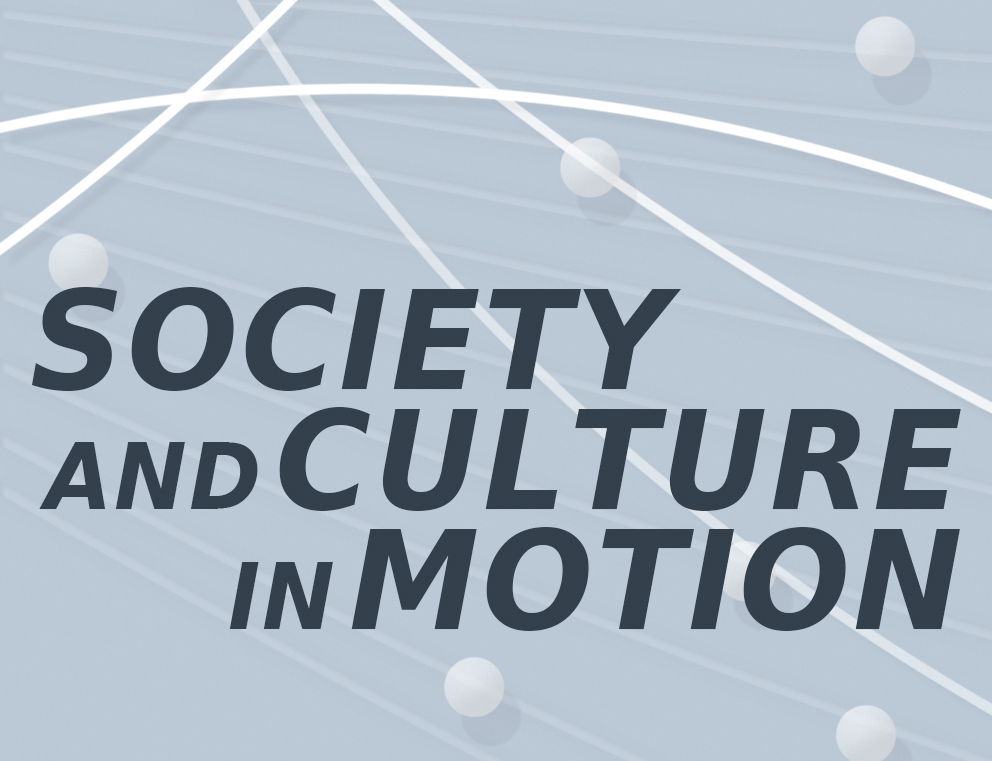The Evaporation of the Original Or Ariadne‘s Thread in the Labyrinth of Intertextuality
by Prof. Dr. Stefan Leder

© Maicar Förlag-GML
Before explaining what this photo has to do with today’s subject matter, I should first explain what I am going to do:
My introductory words are meant to offer a sort navigation help as we try to traverse the huge field of denotations covered by the term intertextuality and adherent theories. I thereby refer mainly to the distributed text, "Fundamentals of Intertextuality" by Heinrich F. Plett. [In: idem (ed.): Intertextuality. Berlin New York 1991, 3-29.] In addition I want to demonstrate that the approach developed by Gérard Genette offers a set of useful instruments suitable to be applied also outside of European and beyond the domains of modern literature [Gérard Genette: Palimpsests. Literature in the second degree. Transl. by Channa Newman, Claude Danbinsky. Lincoln 1997 [Paris 1982]]. I will proceed by offering various digressions and illustrations of the issues to be discussed here. Although it might have been more obvious, I avoid relating today’s subject matter with my one own research field, i.e. early Islamic narrative historiography. I refrain fro it, because I do not want to get too directly involved in my personal interests at this particular instant, as this would lead us into a rather detailed study which might nit be beneficial for all of the very different perspectives and disciplines gathered around the table today. I am also struggling not to overload my contribution, as we are obviously not gathering here in order to give a show of erudition and wisdom, but rather to discuss what we perceive to be central issues in the realm of our section’s interest. However, as the subject matter entails a number of complications, my presentation can not do without a certain density.
On the new website of our section we are pinpointing major issues of textuality and thereby also refer to intertextuality. This short, general and, if you want, somewhat imprecise text refers to intertextuality as a term designating various forms of textual interrelation. I am not repeating the text here word by word; it may suffice to summarize its message: that the concept intertextuality implies a comprehension of various types of textual interrelations, and that it serves as a vehicle for the discernment of more general features of texts, such as their imbeddednes and their constitution.
This harmless little text is as flew as it is general. Moreover, and more important, it conceals that our term is problematic.
As Heinrich Plett is saying at the beginning of his article, the term intertextuality is fashionable and often applied in an arbitrary manner; this may create obscurity and confusion. However, we also may mention that the theoretical framework of intertextuality has spread worldwide thereby producing new terminologies. It is used in Arabic literary theory, applying newly coined Arabic terms, for instance, and it would be curious to know whether a similar development occurred also in Japan, for instance.

It is in this vein that I use the metaphor of Ariadne’s thread in the title of my talk. It is meant to express the idea that we are in need of guidelines. I guess everybody knows the story of how Ariadne, daughter of the king Minos of Crete, helped Theseus. Theseus volunteered to free the Athenians from sacrificing young men year after year to the Minotaur at Knossos. As Ariadne fell in love with the hero, she unveils the secret, explains the labyrinth and gives Theseus a ball of thread that she had produced. Thus Theseus found his way through the labyrinth, strikes the monster and flees together with this lovely maiden to another island. - This promising start does not lead to a good end, however. But I am not pursuing Ariadne’s destiny at this point in order to ask first what a labyrinth has to do with intertextuality. In the middle ages, the labyrinth was used as an allegorical representation, for instance here in the cathedral of Chartre, where a labyrinth is built into the floor. There are various interpretations regarding the signification of this edifice: allegorical, seeing it as a representation of the believer’s path to God, pragmatic, seeing it as a ritual procedure producing amazement and a state of liminality, a state of floating detachment, during the approach to the sanctuary, or, more trivial perhaps, as a replacement of more expensive pilgrimages. In any case, we may state that there is a clear and distinct centre which can be attained in a long and tiresome journey.

Just as the religious labyrinth-concept, the notion of intertextuality is centring upon a conceptual nucleus which is somewhat abstract, lofty and exalted. To carry this parallel further, we may say that these concepts are, unfortunately, of limited practical importance, because the way to the centre is made up of a long sequence of decisions between right and left. Or windings, and is always endangered by failure. But in order to determine, or at least to give a vague idea of what we are aiming at.
It is useful to summarise the central concepts of intertextuality in a provisional manner, which is not meant to be discussed in all profundity at this moment.
1. According to a expression cited by Plett from Charles Grivel there is no text than intertext. (Il n’est de texte que d’intertexte . What is meant here is that whenever a text comes into being it relates to previous texts and in its turn becomes the precursor of subsequent texts.
2. Texts create texts. As Plet quotes from Stephen Heath: « Far from being the unique creation of the author as originating source, every text is always (an)other text(s) that it remakes, comments, displaces, prolongs, or reassumes" We may derivate another thesis from these postulates:
3. Signification is conveyed by the intertext, as well as by the self-confined textual entity authored by an individual.
Some of these postulates will be elucidated in what follows underneath, I hope. However, as a textualist, who is mainly interested in the understanding of real textual testimonies, including the conditions of creation, manners of shaping, dissemination and reception, I would maintain, and recommend, firm scepticism in face of a philosophical approach which does not give proof of its expediency in methodological text analysis.
Here we may return to Ariadne for an instant. The obvious gap between the highly interesting central ideas of the labyrinth-like concept of intertextuality, and the practical analysis of intertextual relations must be filled by some kind of methodological course along which we may move. This is often forgotten over the attractive thought work of that sparkling concept called intertextuality. We need, metaphorically, Aridane’s thread helping us on our pathfinding endeavour. At the same time, the story of Ariadne illustrates the kind of problem that we have to solve.

As the story runs, Theseus left Ariadne ungratefully after taking her to an island. Versions differ with respect to circumstance. More important are attempts to explain why Theseus behaved in such treacherous way; his love to Ariadne’s sister Phaedra is one explication of the tragedy. From 17th century onwards, Theseus’ behaviour inspired many authors. One of the repetitively used heroic explications is that he was too proud to accept Ariadne as his wife, because she had betrayed father and homeland. He thereby forgot, of course, that she had done it for him.

A more equilibrated version, and more correct in terms of modern gender policies, has it that Ariadne, after having been left by Theseus, was discovered and married by the God Dionysos or Bacchus, thus finding her true and exalted destination, as he took her to havens and turned her into a stellar constellation.
Like in many other examples, the mythical narratives about Ariadne gave way to what Plet calls serialization. Obviously, authors produced new versions in response to pre-existing narratives. They thus applied a manner of dialoguing with pre-texts. Reference to previous texts may include various kinds of stance, such as validating the model by emphasizing the exemplary signification of a story; or, in contrast, attempts to deny or transform the original message through parody and satire. All these sorts of references to a previous text can be identified and understood without spreading out the theoretical complexities of intertextuality. As a consequence, we reaffirm here that the concept of intertextuality is in need of that demonstrating its utility in the field of literary, or more generally, textual studies. For the purpose of out exploration we may therefore set the rule, that any methodological approach to intertextuality should give prove of its expediency by improving our understanding of textual interrelations which should, as a result, transcend the traditional approach of identifying and comparing a sequence of similar elements of content.
This, in fact, is the approach of Heinrich Plet. Although he his concentrating on what he calls the grammar of quotation, which is a reductive vision of intertextuality, his article offers a useful and succinct survey of the task to accomplish in the light of our established rule.
In accordance to an expression coined by the philosopher Theodor Adorno, that Beethoven has to be defended against his admirers, Plet defends the notion of intertextuality against the fluidity of its theoretical dimensions advocated by the apostles, as he sees it, or the iconic authorities of intertextuality, such as Roland Barthes, Julia Kristeva and Jacque Derrida. The author wants to regain the dynamism of intertextual sign processes, that means he is advocating an understanding of intertextuality on the basis of signs produced in the texts themselves. He thus wants to overcome static phenomenological accountancy, as he says.
Although he acknowledges the revolutionary heritage of the concept of intertextuality as a rebellion against established cultural and social values, he is missing any comprehensible and teachable method of textual analysis of repetition (intertext is generated by repetition).
He therefore is dismissing a concept of intertextuality which recurs to individual associations and impressions.
Instead he postulates the existence of a intertextual sign arsenal, i. e. markers which signalize an intertext. This vision is motivated by his work on the grammar of quotation which is exposed in some detail. However, the distinctions made operative in this branch of intertextuality may be applied beyond.
A first introductory distinction concerns text and intertext: A text appears as an autonomous sign structure, delimited and coherent in as far as it disposes of an obvious beginning, end, and most important, of deliberately correlated constituents. As a consequence, the integrity of the text is not denied. To the contrary, intertext presupposes immanent integrity of the text and structural relations between texts. The particularity of intertext is that its text referent is not external reality but only another textreferent. (Text referring to text.)
The distinction of material and structural intertext, is of far reaching importance and not confined to the quotation as the one form of interetxtuality which the author has in mind. Whereas material intertextuality is confined to the repetition of material signs, structural intertextuality implies the repetition of code rules. As the author points out, the mixture of both types of intertextuality is the normal case.
The attention to structural interrelation deserves an example, which I take from a book of Salman Rushdie [Salman Rushdie: Haroun and the Sea of Stories. See also: Laurent Bernard: Le détour par le conte : Haroun et la mer des histoires de Salman Rushdie. In : Christiane Chaulet-Achour (ed.) : Les 1001 Nuits et l’imaginaire du XXe siècle. Paris : L’Harmattan 2004, 129-148.]
Rushdie tells the story of Haroun, the young son of a famous story-teller called Rashid. Haroun, confronted with his father’s inexhaustible treasure of fantastic stories, asks his father where these stories come from. Father Rashid’s answer, however, is somewhat unsatisfying, since he says that they come from the Story Sea and that from time he was drinking from its waters. As doubt rises in the heart of the adolescent boy, he gets affected by profound scepticism, which leads him to another question, even more challenging: What is the use of stories that aren’t even true? As in any other good story, also here the hero has to find the solution. He sets out from an experience of los and guilt related to his scepticism. When his mother runs away with the guy from the neighbourhood, she leaves a written note containing, among a number of complains, also this question. The desperate father loses his voice and Haroun, who regrets to have nurtured this fatal question in his mind, meets crisis by merging into a parallel world which is identical with the world of his father’s stories. After finding the sea of stories and its protector and during fabulous adventures he discovers that stories are more than fanciful, meaningless inventions. Haroun is conducted in this imaginary world to save the universe of stories against the threats of silence, and as he regains his father’s voice, his mother finds her way back home.
This little piece of narrative art is in more than in one respect of interest for us: One, Salman Rushdie describes the experience of intertextuality metaphorically, when Haroun comes to Ocean of the Streams of Story:
He looked into the water and saw that it was made up of a thousand thousand thousand and one different currents, each one of different colour, weaving in and out of another like a liquid tapestry of breathtaking complexity. …. Different parts of the Ocean contained different sorts of stories, and as all the stories that that have ever been told and many that were still in the process of being invented could be found here, the Ocean of the Steams Story was in fact the biggest library in the universe. And because all the stories were held here in fluid form, they retained the ability to change, to become new versions of themselves, to join up with other stories and so become yet other stories. (p. 72)For those familiar with early Arabic historiography applying the form of khabar, or akhbar in the plural, this description may seem familiar.
Two, Rushdie refers to the famous 1001 Nights, by using, on a surface level and rather artificially, the most famous figure of these stories, Haroun ar-Rashid, here cunningly distributed to son and father, and by alluding several times to 1001 nights, as in the quotation read out here. Laurant Bernard has shown that Rushdie is transcending ordinary reference which is limited to the reproduction of certain elements of content (material intertextuality). He refers to essential traits of the 1001 Nights and reanimates a central issue of that book which consists in asking for the place, the power and the signification of the narrator’s voice. As Bernard’s study demonstrates Rushdie achieves this by is reshaping or referring to the narrative structure of 1001 Nights, thus applying, in the terminology of Plett, structural substitution. Rushdie demonstrates by way of combining and encapsulating numerous fantastic stories in the account of Haroun’s adventures, the heterogeneity of the universe of stories, far from any didactic impetus. He treats presence and absence of the narrator’s voice as an issue: the father’s voice is present first. then disappears and has to be regained, contrary to 1001 Nights, where the voice of Shahrazad appears in the situation of crisis. In both texts the agents come from a marginal position, powerless, traversing a moment of crisis – in both texts the entire society is threatened and saved by narration.
This digression is meant to demonstrate that the intertext resides in rather immaterial, allusive relation, which is, however, significant and even essential to the "Sea of Stories".
Returning to the fundamentals of intertextuality, we will shortly review the grammar of quotation which offers an inspiring categorization of different types of relationship, which may again be applicable outside of the confines of quotation. As I am not commenting on quotations here – may be Asma has more to say about it because quotations occur regularly in the literature she is studying – I can be rather short with this part of Plet’s article here.
He defines quotations as being 1. repetitive, 2. segmental, 3. representing a derivative textual segment, 4. establishing a removable alien element. He also discusses different aspects of the appearance such as quantity, quality, distribution, contextual interference, code interferences (language, dialect, sociolect, register etc.). As quotations often produce intertextual deviations, he suggests a matrix description, first, on a surface level, by referring to addition, substraction, permutation, repetition. On a deeper level of the intertextual deep structure he rightly mentions that the quotation text achieves the character of a dual sign, since it admits of a proper as well as of more alienated readings.
The author then distinguishes functional modes with respect to sender (one), and perceptive modes with respect to the reader (two). For one he mentions authoritative, erudite, ornamental, and poetic (poeticising and de-poeticising) functions. [[With respect to the recipient he hints to memory depositories, stages of perception and stagnation (no notion of the original context)]]
Many of these categories also make sense when applied to unquoted intertextual references. Although intertextuality beyond quotation is not, obviously, noticeable through markers, it is also based on the principle of repetition. As a consequence, the normative agency which decides which repetition is intertextual or not is the productive/receptive individual whose mnemonic or combinatorial art is a source of continual intertextualities. Textual communication at this point gains openness and arbitrariness with respect to the receptive faculties of the addressee. However, as important as the personal experience are different evaluative attitudes, such as affirmation of intertextuality, based on the assumption that intertextual repetition enhances the meaning of a text (as for instance in the imitation of classisist poetry, as it exists in many languages, such as also in Arabic), negation of intertetxtuality insisting on the inalienable originality of text, and inversion (parody, travesty).

This last point is especially interesting and deserves a short illustration. Habitual attitudes and literary fashions may indeed be decisive for the design and comprehension of intertextual relation. In 1762 James MacPherson published a collection of epic poems under the title of "Fingal. An Ancient Epic poem in Six Books, Together with Several Poems Composed by Ossian, the Son of Fingal". The author claimed to present the poems of Ossian, a legendary Gaelic bard from the third century who witnessed the Scottish heroic war liberating Ireland from the Scandinavian invasion. This is a curious example, as believing in the irreplaceable documentary value of an absent original text is the conceptual ground for the creation of fictitious intertext which is put in the service of a literary reconstruction. Ironically, the intertextual relation may in general reception completely disappear behind the allegedly reconstructed original. As a matter of fact, only the reception decides, as we have mentioned before, whether the intertextual or the purported original traits of the text are taken into consideration.
At a time, when literature began to be seen as the truest expression of peoples and nations, at a time when Johann Gottfried Herder was formulating in his Pragmatic History of Literature (published 1769), that every nation has its own poetry (Dichtung) thus reflecting the potentials of literary expression based upon natural and social conditions, at this time the fictitious intertext invented by MacPherson was widely accepted and eagerly received. The mythical Nordic sage Ossian became a well known figure in literature, and a motif even in heroic painting of the French revolution. As sceptics expressed their doubts about the true origin of the epic, a Gaelic version was produced which was purportedly the original, but in fact a translation of MacPherson’s English text. Only at the end of the 19th century the discussion concerning this text’s authenticity ceased, as it was proven to be a falsification. In this case, the alleged intertext is providing an essential signification (the epic as a testimony of the literary past).
Returning a last time to Heinrich Plet’s article, I refer to his category of substitution which parallels the category of deviation in quotation. I think there is no need here to comment his table of different intermedial substitutions, illustration being a very common transformation of linguistic into visual signs. It has also already been said that many of the phenomena listed as a matrix of intertextual deviation in quotations reappear in this chapter. It is worth mentioning, however, that in non quoted intertext distinction of coordinative and subordinative additions is seen as a key to understand the very kind of substitution occurring in references. At this point, inevitably, Gérard Genette comes into play, because he offers a number of more subtle distinctions. In general, his theory of transtextuality perceives intertextuality besides phenomena called paratextuality, metatextuality, hypotextuality, architextuality. Concerning the forth type, hypotextuality, Genette presents a theory and, may be more important even, a taxonomy of how imitating texts, termed hypertext in his terminology, refer to the pre-text or hypotext. Genette obviously loves to create terminology which may not always be very helpful indeed. In any way his explication of the intended transformation of a pre-text through parody or travesty is very useful. This comment may suffice to convey that Plet’s discussion of various kinds of substitution is not entirely convincing. But there is one aspect which is particular interesting at the end of my talk. When referring to serialization as a phenomenon of syntagmatic intertextuality, that is intertextual transformation occurring on the horizontal axes of communication by the spread of a model of pre-text, he occasionally also refers to paradigmatic axes of intertextual communication. Although treated by Plet rather shabbily, this aspect merits a further comment leading me to my last short very illustrative digression.
The biblical story of Joseph has gained great prominence in literature and may be seen as the starting point of serialization manifest in many literatures. A very striking example for the importance of intertext is the parallel of the Joseph story in two holy scriptures, in the Genesis and the Quran. The relationship of the Quran with versions represented in the Hebrew Bible and in post-biblical Jewish and Christian narrative exegesis, as well as with the tale of Bellerophon of the Iliad and the pre-biblical Egyptian "Tale of two brothers" are obvious and have been studied several times [See also Shalom Goldman: The Wiles of Women, The Wiles of Men. Joseph and Potiphar’s Wife in Ancient Near Eastern, Jewish and Islamic Folklore. New York 1995.] More important, the complexities of the relationship between Quran and biblical tradition in terms of different religious conceptions of scripture and with respect to the difference of historical genesis of the adherent believe systems find reflections in the narrative texture of this story. The Quranic narrative of Jusuf in Sura 12 is, very unusually for the Quran, a rather continuous narrative only sometimes interrupted by commentaries underpinning the didactic character of the story. However these interruptions are important, as the narrative is not presented as history as which is appears in the Bible, but as a parable. This is a clear case of structural substitution of genres.
This point leads us directly to the basic idea I want to convey with this example. There is a number of differences in content between the Quran and the Biblical version on a syntactical level of the narrative. One of the most spectacular differences concerns the role of Potiphar’s wife. In the Quran mutual fascination between Joseph the Pharao’s wife is depicted. She not only appears as a woman trying to seduce the young man, she is as much a victim of his beauty and attractiveness. And she is able to repent, thus regaining her morals. These traits motivated the narrative elaboration of Zulaikha, as she was named later, in Persian literature. However, whereas these differences are to be situated within the narrative structure of the story, naturally effecting its signification, there are other types of transformations which are, as I am tentatively proposing here, pragmatic in character and occurring on a paradigmatic level of interetxtuality. As already mentioned, the Quran’s story is not historical, but didactic. Joseph is not a virtue-hero of the past, the pride of his progenitors, but a man guided by God. As Goldman and in fact also pervious studies show, Joseph’s story parallels in some aspects the biography of the Prophet Mu.hammad. Joseph is presented here as a model prophet, who performs his mission successfully with and because of the guidance of God. The story of Joseph thus gains a new, particular meaning in the Quran which occurs not only by way of what Plet calls a structural substitution, a transformation of genres, but by changing the paradigm making of Joseph an example for God’s guidance to mankind.


